
MINISTRY OF EDUCATION AND TRAINING – MINISTRY OF AGRICULTURE AND RURAL DEVELOPMENT
NATIONAL INSTITUTE OF ANIMAL SCIENCES
============
PHAM QUANG NGOC
USING SEVERAL PLANT LEAVES CONTAIN
TANNIN IN THE DIET FOR MINIMIZE METHANE
EMISSION IN BEEF CATTLE
Major: Animal production
Code number: 9.62.01.05
BRIEF INFORMATION OF PhD THESIS
HANOI - 2019
Hà Nội –

THIS THESIS COMPLETED AT:
NATIONAL INSTITUTE OF ANIMAL SCIENCES (NIAS)
Supervisors:
1. PhD. PHẠM KIM CƯƠNG
2. PhD. NGUYỄN THÀNH TRUNG
Reviewer 1: ……………………………………….
Reviewer 2: ……………………………………….
Reviewer 3: ……………………………………….
The dissertation will be defended at the National thesis council at:
National institute of animal sciences, Thụy Phương, Bắc Từ Liêm,
Hanoi
Time: … h date ….. Month …… year of 20....
The dissertation can be found at:
1. Library of NIAS
2. National library

PUBLISHED PAPERS RELATED TO THE THESIS
1. Phạm Quang Ngọc, Nguyễn Viết Đôn, Lưu Thị Thi và Vũ Chí Cương
(2013). Effect of levels and sources of tannins from Leucaena
leucocephala, Manihot esculenta Crantz, Camellia sinensis leaves and
pure tannin added to the basal diet to fermentation, rumen digestion and
methane emissions from rumen under vitro conditions. Journal of animal
science and technology, vol. 42 Jun 2013, pp 36-60.
2. Phạm Quang Ngọc, Lưu Thị Thi, Vũ Chí Cương, Cấn Thị Thanh
Huyền và Phạm Kim Cương (2014). Effect of levels and sources of
tannins from Camellia sinensis, Acacia mangium, Acacia auriculiformis
leaves and pure tannin added to the basal diet to fermentation, rumen
digestion and methane emissions from rumen under vitro conditions.
Journal of animal science and technology – Vol. 47 Apr 2014, pp 48-70.
3. Phạm Quang Ngọc, Phạm Kim Cương, Lê Văn Hùng, Lưu Thị Thi,
Nguyễn Thiện Trường Giang, Bùi Thị Thu Huyền. Effect of
supplementation of Leucaena leucocephala leaves on diets on methane
emissions, live weight and feed conversion efficiency of growing Red
Sindhy crossbred. Journal of animal science and technology. Vol 103 Sept
2019, pp. 74-87.

1
INTRODUCTORY
1. The necessary of the thesis
The source of methane emissions into the atmosphere from ruminant livestock
production accounts for 12-41% from agricultural production (Afzalani et al. 2015).
Methane occurs in the fermentation of plant organic matter mainly in the rumen, so the
amount emitted is closely related to the amount of feeds intake and digested.
The strategy of changing ruminant diets to reduce methane emissions has
been widely considered (Grainger et al., 2011). A number of in vitro and in vivo
studies have been conducted to reduce CH4 emissions, including the
supplementation of concentrate feeds (Bhatta et al., 2009), lipids (Carulla et al.,
2005), organic acids (Chadwick et al., 2011; D'Mello, 2000), essential oils (Evans
and Martin, 2000) probitics and prebiotics (Fuller and Johnson, 1981; Carulla et al.,
2005). Antimicrobial compounds such as monensin and lasalocid have also been
used to reduce CH4 production (Goel et al., 2008).
So far, the potential for research and use of natural compounds in plants
such as tannins, saponins and essential oils is of interest. Tannins, also known as
polyphenols, are capable of acting as anti-methanogenic substances in the rumen.
The effect of tannin use depends largely on the type and dosage of tannin. Low
molecular weight tannins inhibit methanogen bacteria more effectively than higher
molecular weight tannins, as they form stronger bonds with microbial enzymes
(Ningrat et al., 2017).
The cattle population of nearly 6 million cows in Vietnam of which mostly
beef cattle, also contribute significantly to methane emissions and the greenhouse
effect, while understanding the impact to reduce methane emissions in beef cattle is
still limited, so it is necessary to study the use of plant leaves contain tannin in diets
to minimize methane emissions in beef cattle production.
2. Objectives
Determine the effects of the source and the level of supplementation of several
types of leaves contained tannin on the substrate to the rate and characteristics of in
vitro gas production, amount of methane production, in vitro digestibility, energy
values and short-chain fatty acids.
Determine the effect of dietary supplementation of leaves containing tannin on
methane emissions, digestibility and nitrogen accumulation of crossbred beef cattle
Formulate a diet with supplementary leaves containing tannin to reduce
methane emissions into the environment while providing good live weight gain and
high feed efficiency in crossbred beef cattle.

2
3. Scientific and practical meanings of thesis
The thesis has identified the chemical composition, nutritional value of several
tannin-fed leaf tops common in Vietnam and the effects of the source and the level of
each type of plant to the substrate on the rate and in vitro gas characterization,
methane production, in vitro digestibility, energy value (ME) and short-chain fatty
acid content.
Determined the effect of dietary supplementation of Acacia tree leaves to diets
on methane emissions, digestibility, nitrogen accumulation, live weight gain and feed
conversion efficiency of growing Red Sindhy crossbred.
Formulate a diet supplemented with the tip of Acacia tree leaves at a reasonable
rate to reduce methane emissions into the environment but still increase the live weight
and better feed convert rate of growing Red Sind crossbred in production.
The research results of the thesis are references for the next research, teaching
materials for training institutions, agricultural extension office and farmers.
4. New contributions of the thesis
Have determined the effect of the level of Leucaena leucocephala leaf and shoot
supplementation into the cattle diet on methane emission, digestibility, nitrogen retention,
weight gain and feed conversion efficiency of growing crossbred red sindhi beef.
Have formulated a diet with the optimal supplementation level of the leaf and
shoot of Leucaena leucocephala for minimizing the amount of methane released into
the environment, increase the weight and feed conversion of growing crossbred red
sindhi beef.
Have developed a regression equation that represented the relationship
between the two methods of methane determination (by gas chromatography (GC)
and by the volumetric method with NaOH solution) and made recommendations on
the usage of the volumetric method with NaOH solution to determine methane
emission in the absence of expensive GC equipment.
5. Thesis structure
The entire thesis consists of 166 pages, 4 chapters, 27 tables, 17 figures,
referencing 345 Vietnamese and foreign language scientific papers and articles and
2 scientific research papers related to the published thesis and the appendix.
CHAPTER I: LITERATURE REVIEW
1.1. BACKGROWN OF TANNIN
Tannins are secondary polyphenolic plant compounds, which have been
demonstrated to influence microbial activity during fermentation, protein
breakdown, methane production and minimize pathogen transmission via food

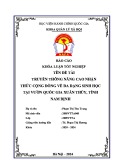

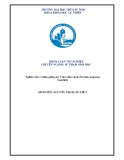


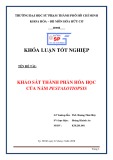
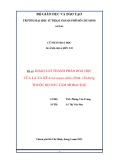
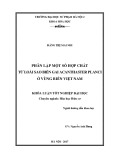
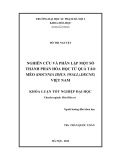
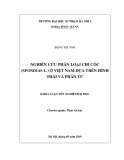



![Ô nhiễm môi trường không khí: Bài tiểu luận [Nổi bật/Chi tiết/Phân tích]](https://cdn.tailieu.vn/images/document/thumbnail/2025/20251011/kimphuong1001/135x160/76241760173495.jpg)







![Ứng dụng kỹ thuật trao đổi ion trong điện phân: Bài tiểu luận [chuẩn nhất]](https://cdn.tailieu.vn/images/document/thumbnail/2025/20250829/sonphamxuan1808/135x160/97341756442892.jpg)



